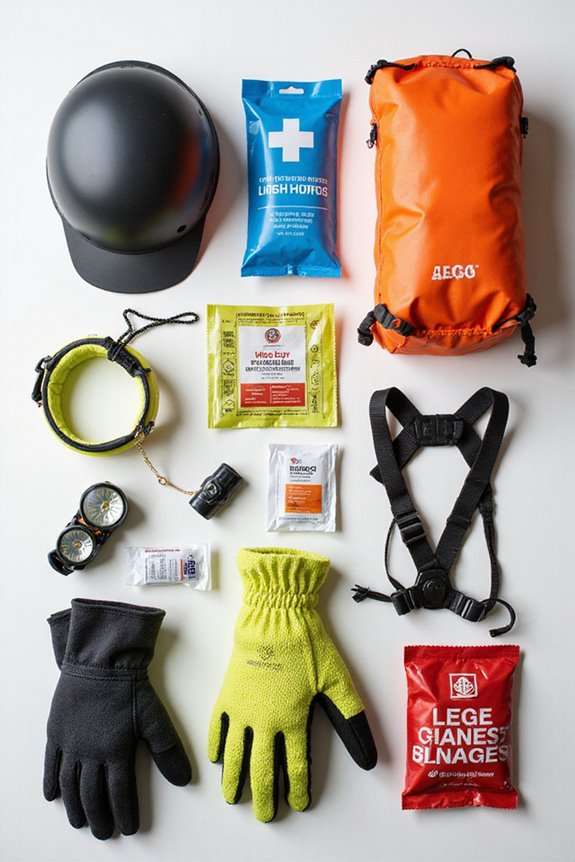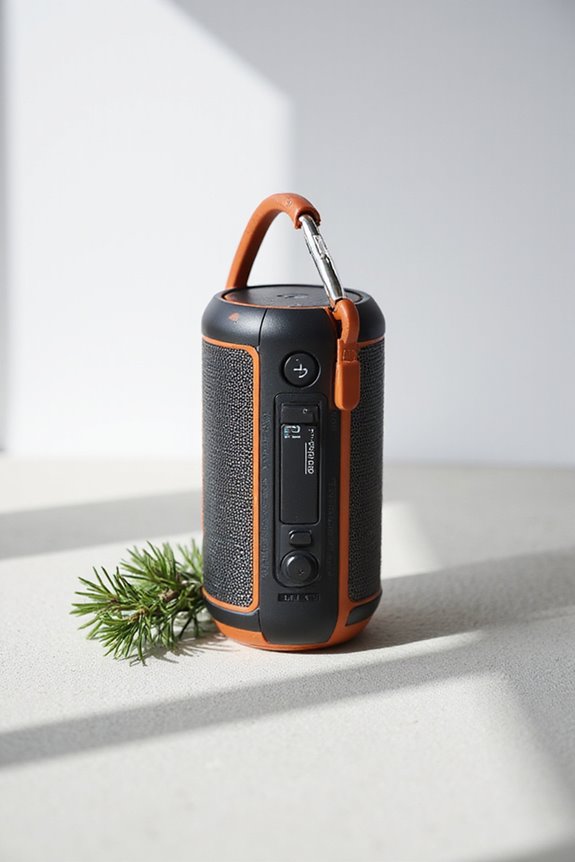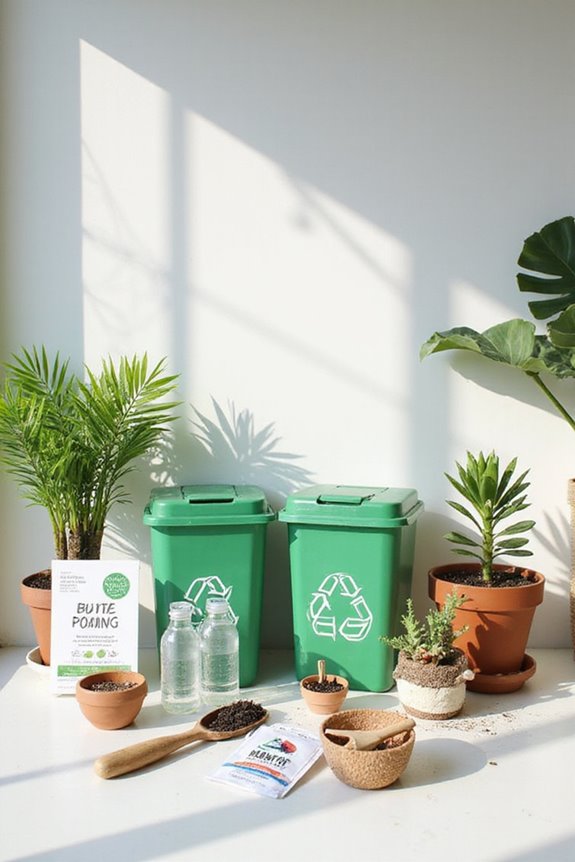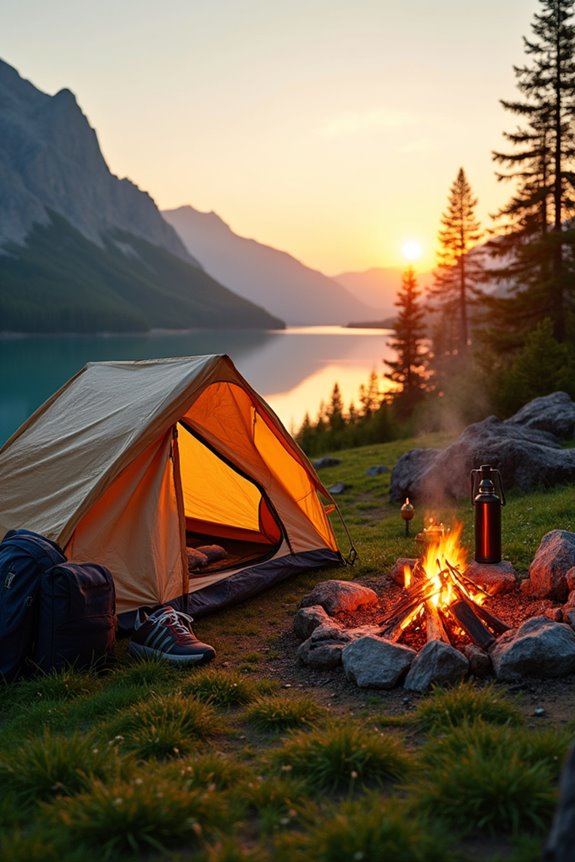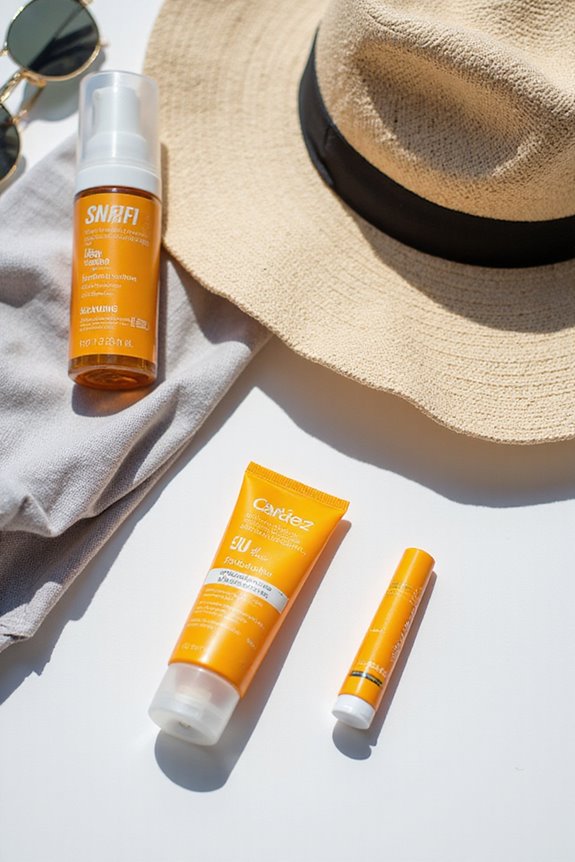When heading outdoors, safety gear is a must! Think multifunctional tools, like a trusty Swiss Army knife, for those unexpected tasks. Don’t forget a reliable compass and a good map for navigation, plus sunscreen and wide-brimmed hats to protect from sunburn. A first aid kit is essential, stocked with bandages and antiseptic wipes. Communication devices, like satellite messengers, keep you connected in emergencies. Want to learn more about prepping for adventure? There’s a lot more to reflect on!
Key Takeaways
- A well-stocked first aid kit is essential for treating injuries and ensuring health during outdoor activities.
- Reliable navigation tools, such as a compass and physical maps, are crucial for safe route planning.
- Multifunctional survival tools, like knives and prying tools, provide versatility for various tasks in the wild.
- Sun protection gear, including broad-spectrum sunscreen, wide-brimmed hats, and UPF clothing, helps prevent sunburn and heat-related issues.
- Emergency communication devices, such as PLBs and satellite messengers, ensure safety and connectivity in case of an emergency.
Multifunctional Survival Tools
When it comes to outdoor adventures, having the right tools can make all the difference, and multifunctional survival tools stand out as essential companions. These handy gadgets, often featuring modular systems, offer a versatile array of functions from cutting to prying. Imagine needing to fix a tent in a downpour—having a multi-tool that combines a knife, pliers, and even a bottle opener right at your fingertips can turn a disaster into a minor hiccup. Tool selection is vital; opting for models that prioritize essential functions helps avoid unnecessary weight. With options crafted from durable materials like high-carbon steel, these tools are built to withstand the wild while staying lightweight. It’s like having a Swiss Army knife on steroids, ready for anything!
Navigation Essentials
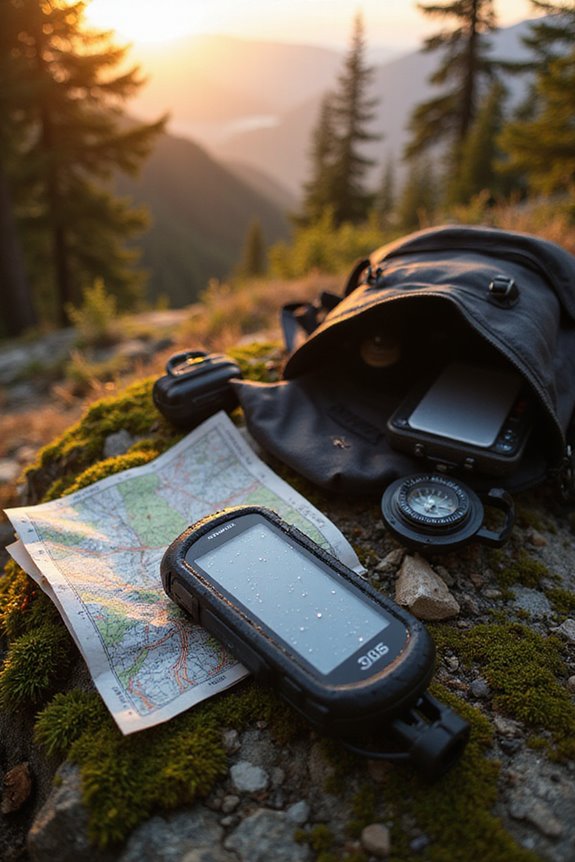
Outdoor adventures can quickly turn from exhilarating to overwhelming without proper navigation tools and skills. Mastering map reading is essential; it helps adventurers visualize terrain features and plan routes effectively. A reliable compass is equally important, with various compass types serving different needs. Traditional magnetic compasses guide through featureless landscapes, while map-reading compasses align perfectly with maps for precise navigation. Baseplate compasses are budget-friendly for easy trails, while digital options, like GPS watches, offer convenience but may falter in tough conditions. Pairing a physical map with your electronic devices is wise, ensuring redundancy. So, whether you’re conquering a mountain or wandering through woods, having these navigation essentials keeps the adventure thrilling, not terrifying!
Sun Protection Gear
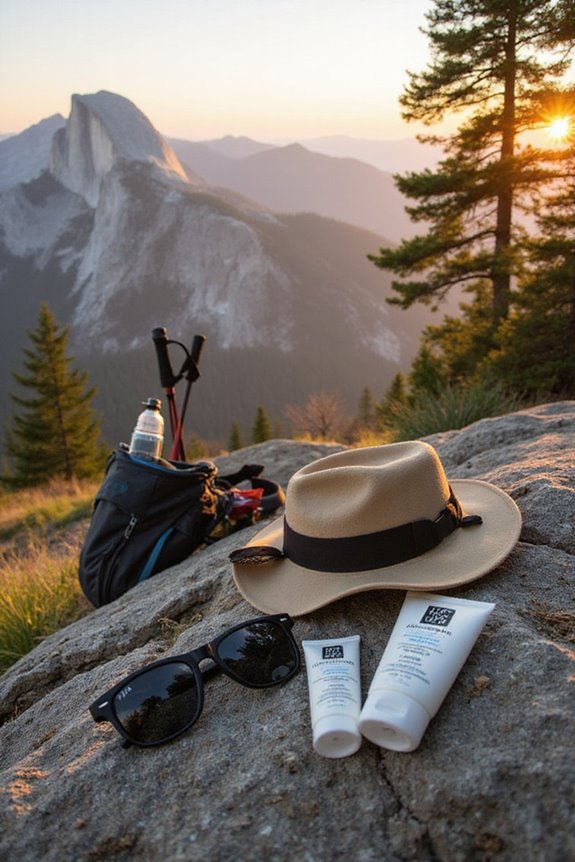
Sun protection gear is a must-have for anyone looking to enjoy the great outdoors without the worry of sunburn or long-term skin damage. Sunscreen application is key; it should be broad-spectrum with at least SPF 30, protecting against those sneaky UVA and UVB rays. Remember to reapply every two hours, especially if you’re sweating or splashing in the water. Pair this with a wide-brimmed hat for extra UV protection, and don’t forget lip balm with SPF—your lips deserve a break too! Opt for lightweight, breathable clothing with a UPF of 50+ for maximum comfort. Sunglasses are not just stylish; they shield your eyes from harmful rays. With the right gear, outdoor adventures can be safe and enjoyable!
First Aid & Health Supplies
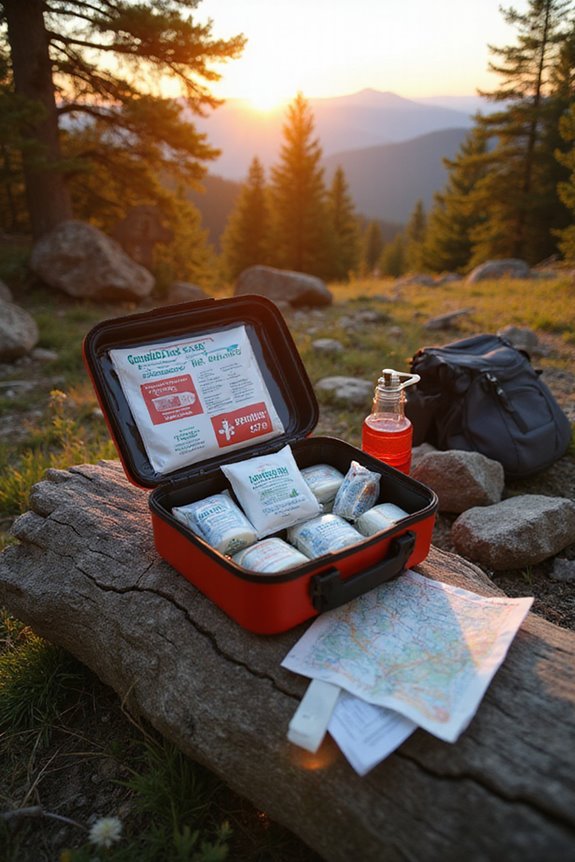
After enjoying a day under the sun, equipped with all the right protection, it’s time to think about keeping everyone safe and sound from the unexpected bumps and scrapes that can occur during outdoor adventures. A well-stocked first aid kit is essential; think antiseptic wipes for thorough wound care, antibacterial ointments like Neosporin for speedy healing, and adhesive bandages in various sizes for those pesky cuts. Don’t forget emergency medications—ibuprofen for aches, antihistamines for allergies, and even EpiPens for serious reactions. Fine-point tweezers can be lifesavers for splinters, while trauma shears make quick work of clothing in emergencies. Remember, a little preparation can go a long way in keeping outdoor fun from turning into a medical drama!
Shelter & Clothing Requirements
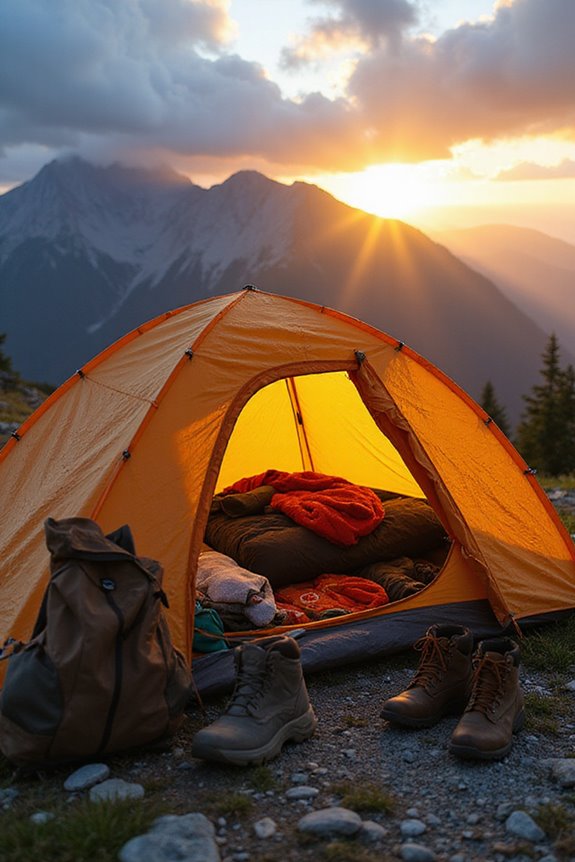
When planning an outdoor adventure, it’s essential to contemplate shelter and clothing requirements, as they can make or break the experience. First up, shelter selection is vital—options like tents, tarps, or even bivy sacks can protect against the elements. Imagine huddling in a cozy tent while rain drums on the fabric! On the clothing front, a clothing layering system is your best friend. Start with moisture-wicking base layers, add insulating mid-layers, and top it off with waterproof outer shells to fend off nature’s surprises. Don’t forget sturdy, waterproof footwear; soggy socks can turn a hike into a misery fest! And hey, packing a hat and gloves can keep you toasty when temperatures drop unexpectedly. Additionally, choosing a tent with high waterproof ratings can ensure you stay dry during inclement weather. Adventure awaits, so gear up wisely!
Nutrition & Hydration Strategies
Nutrition and hydration are the unsung heroes of any outdoor adventure, often overlooked but essential for keeping spirits high and energy levels up. To maximize performance, adventurers should focus on nutrient timing; packing a balance of complex carbohydrates, lean proteins, and healthy fats fuels the body effectively. Think energy-packed peanut butter sandwiches and crunchy nuts, perfect for those long hikes! Hydration tips include drinking water consistently and snacking on juicy fruits like watermelon and oranges to stay refreshed. Electrolyte-rich drinks can be lifesavers, preventing cramps during intense activities. Remember, it’s not just about quenching thirst—it’s about maintaining stamina and keeping those spirits soaring. So, pack wisely, hydrate often, and enjoy the great outdoors!
Emergency Communication Devices
In the wild world of outdoor adventures, having a reliable way to communicate in emergencies can feel like packing a superhero cape—essential for staying safe and connected. Emergency communication devices are vital, offering various options like Personal Locator Beacons (PLBs) that send one-way SOS signals, perfect for backup. For those craving more interaction, satellite messengers provide two-way communication, allowing texts and GPS navigation. Two-way radios shine in group settings, ensuring communication reliability even in remote areas. And let’s not forget mobile mesh networking devices, keeping everyone connected within a 10-mile radius! With these gadgets, adventurers can feel confident, knowing they have a lifeline, even in the most isolated places, turning a potentially scary situation into just another adventure story to tell.
Safety Planning and Preparation
Adventure enthusiasts know that a well-planned trip is like a map leading to a treasure chest of unforgettable experiences. Safety planning and preparation begin with a solid risk assessment; understanding trail length, elevation, and potential hazards is essential. Crafting a detailed trip itinerary helps keep adventurers organized and aware of their physical limits. Weather can be unpredictable, so checking forecasts and preparing for anything from sunshine to storms guarantees everyone stays comfortable. Reliable navigation tools like maps and GPS devices are must-haves, as relying solely on phones can lead to trouble. Finally, packing a first aid kit and knowing basic emergency skills makes all the difference when facing unexpected challenges. Adventure awaits—just make certain to prepare!
Frequently Asked Questions
How Do I Choose the Right Outdoor Footwear?
Choosing outdoor footwear resembles selecting a sturdy vessel for a journey. Understanding footwear types and following a fitting guide guarantees comfort, support, and protection, allowing adventurers to navigate diverse terrains with confidence and ease.
What Are the Best Practices for Wildlife Encounters?
Best practices for wildlife encounters include maintaining a safe distance, using encounter strategies like shouting or backing away slowly, and adhering to wildlife safety guidelines. Awareness and preparation greatly reduce risks during outdoor activities.
How Can I Stay Safe During Extreme Weather Conditions?
Amidst unpredictable storms, he emphasized weather preparedness. Equipped with emergency supplies like first-aid kits and reliable communication devices, he navigated through extreme conditions, ensuring safety while embracing the challenges of nature’s fury.
What Should I Include in a Personal Emergency Plan?
A thorough personal emergency plan should include emergency contacts, a well-stocked first aid kit, and clear communication methods. Regular reviews guarantee preparedness, enabling individuals to respond effectively to unexpected situations and coordinate assistance when needed.
How Do I Manage My Energy Levels During Long Hikes?
While some may underestimate the importance of energy management, maintaining hydration strategies and consuming energy snacks throughout the hike are essential for sustaining endurance, preventing fatigue, and ensuring a successful outdoor adventure.

